Expert Q&A: Caroline Nash
By Amy Nelson
 How did you become interested in beaver?
How did you become interested in beaver?
I sort of fell into this backwards. My background is in hydrology and geology. My adviser and I had come to a site in eastern Oregon to study the hydrologic implications of wet meadow restoration–the kind of restoration that tries to reestablish wetland ecosystems along former floodplains of incised channels. We were interested in how water budgets partition out when you do that kind of restoration. It just so happened that the privately owned ranch where we were doing this research was using what they were calling “artificial beaver dams.” This was my first exposure to the idea of using beaver, or structures designed to mimic beaver dams, as a tool for environmental restoration. My interest expanded from “What do these wet meadow restoration projects do?” to questions such as, “What is the capacity of beaver-related restoration? How do artificial structures compare to natural beaver dams? What kinds of physical changes can we expect to see in these systems as a result of beaver-related restoration, and how universal are those changes? What will the scale and timing of those changes be?”
You are part of a multi-disciplinary team of scientists researching beaver-related restoration. Tell me about that.
Obviously, NOAA’s Northwest Fisheries Science Center has produced a lot of research out from their work at Bridge Creek on the use of Beaver Dam Analogues and how they affect temperature, groundwater, riparian habitat, and sediment deposition. There are also a lot of private and public projects using other methods sprouting up throughout the Intermountain West.
Part of the reason our group was established was to bring together all of the different people and disciplines necessary to answer remaining questions about beaver-related restoration. As soon as you start invoking wildlife as geomorphic, hydrologic, and geologic agents of change, there are a lot of factors at play.
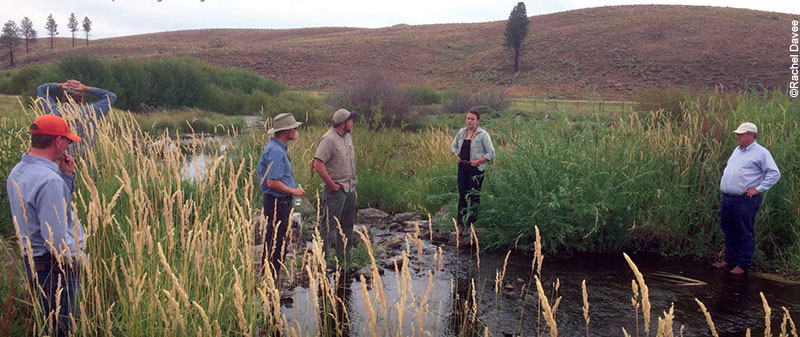
The lead author of our paper, David Pilliod, is an ecologist with experience working in wetland ecosystems. I am a hydrologist/geologist, and our team also included sociologists, experts in geomorphology, hydrology and remote sensing, an aquatic ecologist, and a wildlife biologist with expertise in beaver management & conflict resolution. It has been exciting to be part of this group because we have been able to start parsing out some of the inconsistencies and identifying areas where the research is lacking or where we need to concentrate more resources.
Many of those inconsistencies were revealed in the paper your group released, “Survey of Beaver-related Restoration Practices in Rangeland Streams of the Western USA,” which was published in the journal Environmental Management in November of last year—and we’ll get to those. But first, what prompted you and the other authors to write that paper?
There have been many papers evaluating individual case studies, and the group at Bridge Creek has produced quite a bit of peer-reviewed research assessing Beaver Dam Analogues, but our paper was the first inventory of beaver-related stream restoration projects. Our goal was to get a sense of where these projects were being done, who was doing them, what strategies were being used, and what kind of information was being collected. This is a rapidly growing field—in terms of the number of projects being done and the amount of information becoming available. We really wanted to hit the “pause” button and capture a picture of what it looks like right now.
Your group produced an actual picture, in the form of a map. Could that map be the beginning of some kind of national database of beaver-related restoration projects?

I certainly hope so. It is so important to not only have good case studies of individual projects, but to also have the big picture so we can start trying to see if certain outcomes are universal or site-specific, if parallels can be drawn, and if outcomes only happen in places with certain hydrology or certain regulatory environments, etc. We want to parse out what leads to success. The more information we can put on map, the better.
For the 2017 paper, your group assessed 97 projects that had been implemented by 32 organizations from 1950-2016 (with most having been implemented within the last 10 years). 76 of the projects studied used beaver translocation and only 14 involved mimicking beaver dam effects. The paper states that beaver translocation initiatives have increased considerably in recent years, but projects using artificial structures have increased much more slowly. Why do you think that is?
One of the main reasons is the goal of the project. The most common goal of surveyed translocation projects was the relocation of nuisance beaver. Since that is such a major motivator for action, it makes sense that translocation is a more common strategy.
I can also speculate that projects involving artificial structures require a lot more planning, permitting, and expense. There are also a lot of unknowns regarding the tradeoffs of artificial structures. There is so much variety amongst the kinds of structures being used. What structure is best suited to what area? Which structures are more or less likely to lead to which outcomes? Which structures are appropriate for which projects? Given these unknowns, and the large amount of work required to physically manipulate the system, there just aren’t as many people who are willing to take on that risk or have access to the amount of funding required.
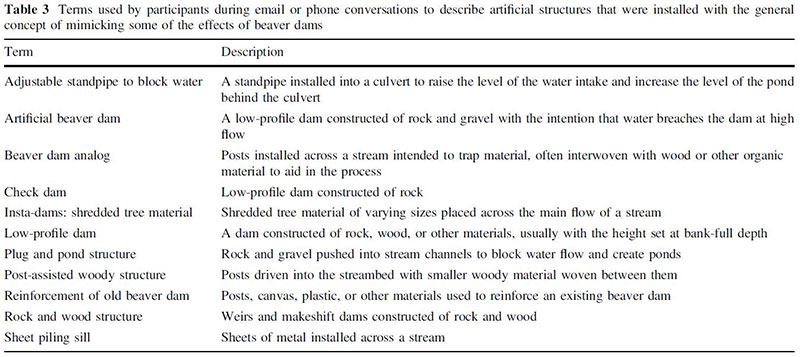
Were most of the people who considered the beaver to be a nuisance farmers and ranchers?
That question speaks to something that we were very interested in: the social dimensions of beaver-related restoration. That is something that we hydrologists and geologists often neglect. It is a very important factor in evaluating why people chose to do what they do, and what counts as success in their minds. It is also crucial for building more collaborative projects.
It is quite common to relocate beaver from urban or suburban areas, where they can be in conflict with denser populations and infrastructure, out to rural areas. Vanessa Petro has done quite a bit of work looking at this.
How were most of those projects funded?
Many of the projects we assessed were carried out in partnership with the U.S. Forest Service. They often involved partnerships with state natural resources management agencies, universities, and tribes. They were often very agency-driven.
Let’s look at the major points of discussion within that 2017 paper. The first point is that “Beaver-Related Restoration Encompasses a Broad Range of Practices for a Broad Range of Goals.” The Beaver Restoration Guidebook emphasizes the importance of identifying project goals—around which strategies and objectives should be developed-as an essential first step in beaver restoration projects. Your paper suggests, however, that project goals are often quite general, and this can lead to problems when it comes to selecting the best beaver-related restoration tool. Can you talk about this?
As someone who works primarily in hydrology and geology, I think about goals as hypotheses. Having a very clearly outlined project goal that explicitly states the timeline at which you expect the response to occur and the amount of measurable change you expect to see over a specific area allows us to assess success in terms of achieving that specific goal. It also allows us to collect scientific information about that project, so we can say, “In this particular location, with these site characteristics, we were able to see this amount of change at this scale.”
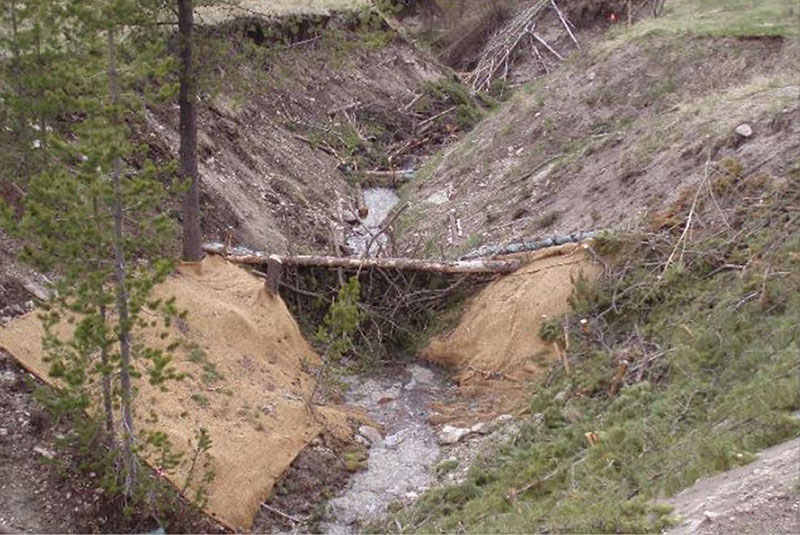
The issue of scale is important when a project goal is set. Say you have a goal of sediment aggradation, and you really want your beaver-related restoration to deposit sediment in the channel. My next questions would be: “How much aggradation do you want? Five centimeters or a meter? How much aggradation is necessary to meet your project expectation?” If the expectation is that they want to increase the frequency with which winter floods spill out over the channel banks onto the floodplain, we need to know how frequently it floods now. We also need to know how much additional sediment needs to be deposited to make flooding more frequent with typical winter flood flows. We also need to understand how quickly they expect to see sediment aggradation. Do they expect it to occur in five years or a hundred years? Do they want it to aggrade in the channel, on the floodplain or both? Do we want to see it uniformly along the entirety of a 10-mile channel, or at a couple of point locations where it is particularly problematic? Once we have those benchmarks in place, we can really target a monitoring design to directly measure progress toward those specific goals.
This is not to say that other changes or benefits cannot be realized outside of those goals, but only when we start setting very clear, time- and space-bounded goals can we can begin providing information about project effectiveness. We may discover, for example, that in one location we did not get as much sediment aggradation as we expected in the timeframe we expected. Why is that? Maybe we can say that within the five years we were doing monitoring we had unusually dry conditions so sediment wasn’t being moved in as quickly, or maybe there was an upstream management change, or maybe our assumptions about how the restoration would work were flawed. We can start pinpointing things that are causing the success or lack of success, so that we can improve design at that location or possibly look to other locations. We can more easily build upon lessons learned.
Speaking of targeted monitoring designs…only 22% of the projects assessed in the 2017 study involved any post-implementation monitoring. Were you able to determine why?
Funding is, and will always be, a major factor. One of the big appeals of beaver-related restoration strategies is that they cost less than other stream restoration techniques. But as soon as you start adding on monitoring equipment and personnel, those costs can rise quickly. Private landowners implementing beaver-related restoration projects also have day jobs, and many other things to manage on a day-to-day basis. Having the support for monitoring is important. If a private landowner wants to set up set sediment aggradation stations so they can take measurements, we should have the resources available to quickly give them the tools they need and clear explanations of where and how to install the equipment and how frequently to take measurements. Part of setting up collaborative and cost-effective monitoring comes from setting clear goals at the outset.
A major discussion point in the 2017 paper is that “Restoration Assessments will Benefit from Including Social as well as Ecological Components,” which you touched on earlier. The paper points out that structures like Beaver Dam Analogues “may enhance a rancher’s resilience to drought by retaining water in stream systems later into the summer, but they may also affect the timing of hydrologic flows and water availability to downstream users,” thus potentially raising water rights concerns. Do you know of any cases where this has happened?
One of the very first papers that I saw published related to beaver dam hydrology was by Woo and Waddington in 1990. They documented that by virtue of increasing the amount of surface area of water in a watershed by creating ponds and raising water tables, beaver dams increase the amount of evaporation and evapotranspiration, thereby decreasing outgoing streamflow. This was followed by a paper by Burns and McDonnell in 1998, which also showed that the amount of evapotranspiration leaving beaver ponds is not insignificant. This outcome is very site specific, but just from a physical standpoint, when you increase surface area that drastically and raise water table levels back to within the root zones of wetland plants with high daily water usages, you can’t just increase the amount of outgoing water in that way without there being a tradeoff somewhere else in your water budget.
This can be hard to document, though. Getting stream flow data on drainages with beaver dams or artificial structures on them is often difficult. Sometimes the changes are so small we can’t measure or detect them. Sometimes, you are comparing a downstream stream gage with an upstream stream gage, but if that downstream gage is not immediately below the dam, there could be a tributary, and it will have a larger contributing drainage. It gets hard to pull apart what is or is not the result of beaver dams when it comes to stream flow.
I recently learned about a case in the Deschutes Basin in central Oregon that doesn’t explicitly involve beaver, but does address the issue of increasing evapotranspiration through wetland restoration, which parallels a lot of the concerns around beaver in dryland environments. Specifically, this project was aiming to restore a wetland through floodplain reconnection, but a downstream irrigation district asserted that the restoration would limit in-stream flow during critical irrigation periods. They ended up negotiating a deal where the USFS established a Pilot Phase for the project to measure how much water levels were affected by the restoration, and the Irrigation District leased the amount of water necessary for the restoration in exchange for habitat mitigation credits under the Deschutes Basin Habitat Conservation Plan [see this article for details].
How often is this loss of water from evaporation and evapotranspiration not considered?
In my view, this is one of the most overlooked things in beaver-related restoration: we really need to be considering the water budget. Water is a limited resource, particularly in semi-arid areas. We only have as much water as Mother Nature gives us through precipitation, and we can only partition it so many ways before there simply is not enough to fulfill all the uses we want it for.
One of our goals in pursuing this work is to set boundaries around what is possible. Can we increase riparian vegetation, stream flow, and surface water all at the same time, or might we have to give one up to achieve the other?
How can we evaluate the effectiveness of beaver-related restoration of incised streams in situations where we don’t have any control over land use and management practices and they are unlikely to change?
It all starts with identifying really clear goals with time frames and spatial scales attached to them. From a scientific perspective, it is actually better if land use and management practices don’t change because we can more clearly pinpoint the actual causes of change if we are introducing beaver or installing structures. Obviously, we know it is more than just an experiment, because people have hopes and expectations. When you are working with private landholders, livelihoods can be on the line, so we can’t treat beaver-related restoration as an academic exercise. We need to apply scientific principles while also trying to create as many metrics and chances for success as we possibly can.
We all share the goal of wanting to see these landscapes become healthier and more resilient. But when it comes to evaluating the effectiveness of these projects, we need to be very clear about our goals so we can measure them, and determine if we are choosing the right restoration techniques to achieve those goals.
One of the conclusions of the 2017 paper was that there is a need for better “pre-restoration planning.” What does that better planning look like?
From my perspective, it really does relate to those clear goals: being explicit and specific about what change we want, how much change we want, when we want it, where we want it, and—bringing in that social aspect—why we want it.
The 2017 paper identified many areas where there are gaps in knowledge. What research do you think is most urgently needed?
The inventory David led revealed that other than relocating nuisance beaver, increasing water was the most commonly cited reason for choosing to use artificial structures and the second most commonly cited reason for using beaver directly. That bears a lot more consideration, especially with how variable water availability in the summer has become, and how tied to that availability we are. Going back to my earlier point about goals, when someone says they want to increase water, we need to clarify what kind of increases they are looking for (e.g., groundwater or surface water?), what time of year they want that water, and how much is necessary to create the change they hope to see result from that increase in water.
Surveying goals and expectations is important. We need to get a better understanding of what people’s expectations of beaver-related restoration are so we can evaluate whether those expectations are achievable using beaver-related techniques. Are there certain geographic locations where we’ll be more or less likely to see that change? Will there be tradeoffs we’ll need to contend with as a result of choosing this strategy? That is the important part of this research. We really need to understand some of those challenges.
Another area where we need more research is related to beaver dams and stream temperature. This has been a long-standing question mark, and very recently, research has come out that begins to address that question (Weber et al. 2017). It is great to see this research, and we are only touching the tip of the iceberg with regard to thermal profiles in streams that have beaver dams or artificial structures. We still have a lot of work to do to evaluate changes in temperature over a broad range of stream systems containing a variety of different water quality issues and species of concern.
Research resources on East Coast?
Denise Burchsted, who is based out of New England, published a paper in 2014 about the alterations that beaver dams create on headwater streams in Connecticut. That is a great paper, and she is a very respected researcher in the field.
Can you tell us about research you have been conducting in a meadow in the floodplain of Cottonwood Creek in eastern Oregon? How is it influencing your perspective on beaver-related restoration?
This is the project where I stumbled into beaver. We initially intended to evaluate the hydrologic implications of wet meadow restoration, but when we encountered some permitting issues, the original research plan went out the window and a whole new world of questions emerged. I became interested in trying to understand the features we were trying to restore. With regards to wet meadows, this meant actually looking at the geomorphic surfaces—those valley bottoms–and trying to understand why there was a wet meadow there to begin with before degradation and incision. I’m interested in understanding the cause of degradation and using that to inform the strategy we use for restoration.
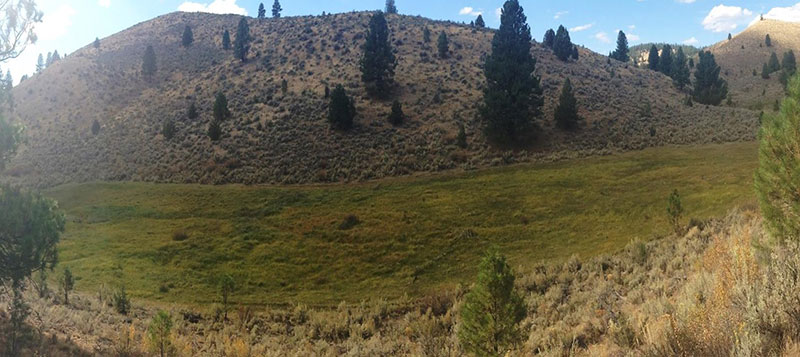
In the case of Cottonwood Creek, we are looking at very deep meadows with sediment that, in some places, is 30 feet deep. Did a beaver cause that, or was it actually caused by something geologic, like a landslide? If a beaver built a meadow, and we removed the beaver and the meadow degraded, and we put the beaver back in…that’s a pretty solid line of logic for restoring that meadow. But what if a meadow is in a certain location because of larger-scale geologic processes? If it begins to incise and we put a beaver in to fix it, the scale of restoration may not match the scale of the degradation. This is another way we can set realistic expectations for our restoration programs: targeting landforms that can change, and whose degradation can be linked to the method we’re using for restoration.
My perspective on beaver has also been influenced by the work and geologic perspectives of Grant Meyer out of the University of New Mexico, and Ellen Wohl at Colorado State. They are examining how much evidence we have to support the long-term influence of beaver on valley bottoms (Persico and Meyer, 2009; Polvi and Wohl, 2011). There is this long-standing idea that when you see a valley bottom, it is because beaver have aggraded sediment to create it, but is that true in all locations? Both Meyer and Wohl and their students have done great work looking into that. I am hoping to add to that literature with some of the work that we are doing at Cottonwood Creek, where we are trying to determine if we have evidence of beaver-related sedimentation or if the sedimentation is due to geologic processes.
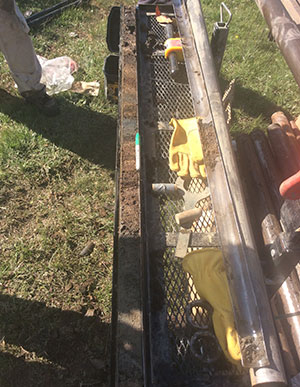
So what are you learning about the meadows around Cottonwood Creek?
Then we used electrical resistivity (the opposite of conductivity), which involves sending a current into the ground and measuring how quickly and strongly that current is received by electrodes further down the line. That tells us how conductive or resistive the material is in that area, which often corresponds either to how much clay there is or if there is water present. When combined, those methods start to give us a really useful, three-dimensional picture of what we are standing on top of. I’m still processing the data, but we have done some very exciting analyses. The first thing we did was take a bunch of cores to see what the meadow was made up of. In the uppermost meadow, we found an impressive depositional sequence. We could see different tephras (ash layers) for various volcanic eruptions, which are great markers of time. That told us that this uppermost meadow is a place where sediment has been getting deposited for a long, long time (>1200 years).
Our uppermost meadow appears to be fairly long-lived. The data we are seeing for this meadow is consistent with what we might call a “geologically controlled depositional” area, which means it is like a giant bath tub that is being filled with sediment and water, and that is the reason the meadow is there. That tells us that geology is likely the reason this particular meadow exists.
Meaning beaver were not the primary engineers of that landscape?
Not for this particular meadow. But there is some evidence that beaver are using geology and surface geomorphology as cues to build dams in certain places, which can enhance the wetland conditions of those places. Beaver still played a role here; it just might be a different role than we previously thought.

So could the notion of beaver being second to humans in terms of their influence on the landscape be a myth?
It’s not so much that it’s a myth. It just may not be as universal as we think. There is nuance to it, and that is the beauty of this kind of research. It’s less that we are disproving things and more that we are detailing the cases for which it is true, and the cases for which it is not.
You have said, “One of my biggest takeaways from working in beaver-related restoration is that all too often, we invoke beaver without considering their actual behavioral ecology.” Can you elaborate?
I have been very fortunate to work on a multidisciplinary team that included an expert in beaver ecology, restoration, and relocation (Dr. Jimmy Taylor). He really brought to light the fact that some of the fundamental assumptions we make about how beaver are going to behave are not grounded in the data we have about them.
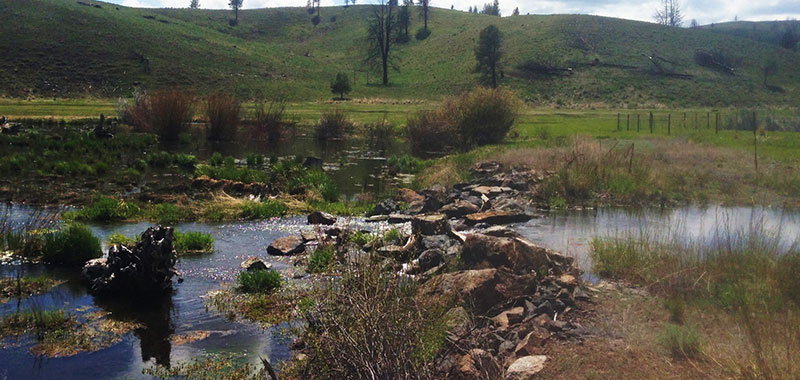
One of the unique things about beaver related restorations is that we are depending on the efforts of an entirely different species to behave in ways that meet our objectives for ecological restoration. Beaver aren’t under contract with humans! It is important to understand how the things that drive their behavior work for or against our human objectives for restoration. I’m convinced that we need to bring people well versed in beaver ecology to the table whenever we are invoking beaver in restoration.
Any final words of wisdom or thoughts to share with our readers?
My biggest takeaway from this research is that with all beaver-related restoration, whether it actually involves beaver or an artificial structure intended to mimic a beaver dam, we are still at a point in our understanding that we need to treat it as a experiment. We need to be careful in the expectations we set, and in the expectations that we – as researchers and practitioners – give to the people we’re working with. One of the biggest dangers of not doing that isn’t just the potential ecological damage or hydrologic tradeoffs. Maintaining people’s faith and hope in science and in the resilience of the natural world is crucial in working towards healthier ecosystems, no matter the chosen strategy. We need to build and maintain trust, and that requires setting expectations that can be met by strategies we’re using. We cannot afford to lose hope and trust. We need to have clear expectations and set reasonable goals so that we are not setting ourselves up for failure, frustration, and cynicism.
